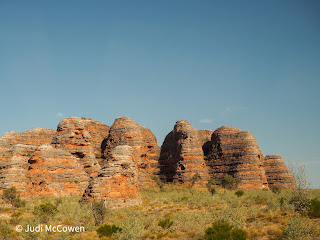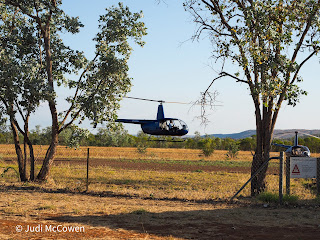I have a bucket list of places that I would like to visit and things I would like to do. The list is extensive but right up their in the top ten is to visit the Bungle Bungles. I have looked at photographs of these incredible bee-hive shaped rock formations and knew I just had to see them. Today was that day.
We were picked up for our eight hour tour at 8.30 and were well and truly on time to board our 9 am flight to the Bungle Bungle Range that sits proudly inside the World Heritage listed Purnululu National Park. After the standard safety instructions we were seated on board our fully air-conditioned 14 seat Cessna Caravan and in no time at all we were soaring over Kununurra.
The view over the Ord Irrigation Area, Lakes Kununurra and Argyle and the Ord Top Dam Wall was stunning from the air. The chequerboard patterned paddocks in the Ord grow a variety of crops including Mangoes, Citrus, Watermelons, Rockmelons, Pumpkin, Chickpea, Chia & Sandalwood. We will learn more about this on the tour we have booked for Saturday.
After a circle over Lake Argyle our pilot takes the plane higher and we head south towards the Bungle Bungles. To our right is the Argyle Diamond Mine that we are assured we will get a better look at on our return flight. We fly over the Carr Boyd Ranges, Osmand Ranges, the mighty Order River and Bow River. The rivers seemingly snake their way through the countryside carving out gorges as they go. The flight takes us around one hour and below us we get our first glimpse of the Bungle Bungles.
The airstrip is gravel but the pilot lands the plane with ease and taxis us to our waiting bus and guides. It is a quick transfer from plane to bus as the temperature is still quite high at around 36 degrees. The air-conditioned bus that we travel in to the Bungles is brand new and our driver/tour guide handles the road well. He chats to us on the 20 minute drive to where we will begin our walk and he is very interesting. He talks about the aboriginals and the cultural significance of the Bungle Bungles to them. Up until 1983 the only people that knew about the Bungle Bungle were the local Aboriginal people, pastoralists, stockmen and few helicopter pilots. It was decided that in 1987, due to the unique landscape, significance to the Aboriginal culture and tourism potential the Bungle Bungle and surrounding areas would be established as a National Park.
We arrive at our destination and we are shown a map of what we will be visiting: The Dome walk, Piccaninny Creek and Cathedral Gorge. We are all handed insulated lunch bags that we carry with us to Cathedral Gorge where we will stop for lunch. Our guide leads off towards the Dome Walk stopping at various places to point out different plant species and rock formations. We learn how the Bungles are formed over 360 million years ago when sand and gravel was deposited by rivers flowing from the north-east. Erosion by creek, rivers and weather in the past 20 million years has carved out these domes, along with the spectacular chasms and gorges.
We head to Picaninny Creek where we are shown holes in the sandstone that have been eroded by the heavy monsoon rain. They are the perfect size to bath in and the Aboriginal's used these holes to bath their babies (Picaninny).
A further 800 metres along the path we reach our final destination, Cathedral Gorge. It is really hard to describe the sheer size and magnitude of this place. I cannot fit the height of the towering domes into a photograph! We notice the temperature drops as we walk through the towering cliffs to reach this awe-inspiring amphitheatre of red rock with its natural acoustics. Water pounds through here in the wet season and a pool of water in the middle still remains.
 |
| You can just make out some of our tour group at the bottom of the photo just to give you some idea of the size of Cathedral Gorge and I still couldn't fit the top in the photo! |
Our aboriginal guide tells us that the Bungle Bungles is his tribes home as they are river people, and where we are seated inside the Cathedral dome was once a mens only area. I am so grateful that the traditional owners allow us entry to this magnificent area. I sit quietly, as does everybody else in our tour group, and eat from my lunch box. I can't stop looking up.
After about an hour our guide gathers us all together for the return walk back to the carpark. The walk is around 3km return and the surface is sandstone, sand and some rocks. We have to climb a short ladder to reach Cathedral Gorge but it is easy. In fact the whole walk is easy.
Back on board our bus we are taken to Savannah Lodge for afternoon tea of scones, jam and cream as well as some seasonal fruit. Tea and Coffee is also available. Some of our tour group are staying the night at the lodge and I can see that there are huts scattered around. It looks very welcoming. We only have 20 minutes at the lodge before we drive the short distance back to the airstrip and our waiting plane.
The flight back to Kununurra takes us over Rio Tinto's Argyle Diamond Mine that ceased operations in 2020. It is a huge mine and the diamonds were mined above ground initially before underground mining commenced. The mountains of mined land is the loveliest pink that is of course the colour of the diamonds that were mined there. The sun was sitting low in the sky when we flew over the mine and by the time we arrived back at Kununurra the sun had set.
As I recall our day I'm reminded of just how beautiful our country, Australia, really is. The area we visited today in the Kimberley's is unlike anything else in the entire world and yet it is an unknown to most people around the world. We should be grateful for that!




























No comments:
Post a Comment